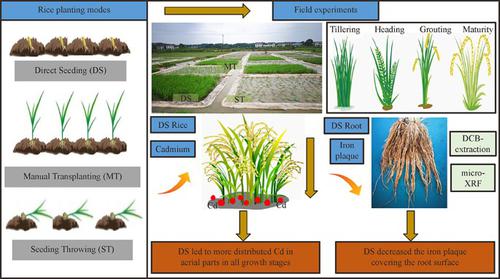Frontiers of Environmental Science & Engineering ( IF 6.1 ) Pub Date : 2021-04-10 , DOI: 10.1007/s11783-021-1431-5 Xiao Deng , Yixuan Chen , Yang Yang , Liang Peng , Luo Si , Qingru Zeng

|
Global rice production practices have gradually changed from a reliance on transplanting to direct seeding. Yet how this shift may alter cadmium (Cd) accumulation in rice is poorly known. Here we conducted field experiments with two rice genotypes cultivars that were planted using three methods: via direct seeding (DS), seedling throwing (ST), and manual transplanting (MT). Rice samples were collected during four growth stages. The formation and distribution of iron plaque were analyzed using DCB (dithionite-citrate-bicarbonate) extractions and observed under micro-XRF (micro X-ray fluorescence). The results revealed that, in each growth stage, DS rice was more apt to harbor Cd distributed in the plant’s aerial parts, and the Cd concentration of brown rice from DS was 21.8%–43.3% significantly higher than those from ST and MT at maturity stage (p < 0.05). During the vegetative stages, the Cd uptake percentage was higher in DS than MT rice, and those plants arising from the DS method were capable of absorbing more Cd earlier in their growth and development. Conversely, using DS decreased the amount of iron plaque covering the root surface in every growth stage, especially in the critical period of Cd accumulation, such that the roots’ middle areas were distinguished by a near-complete absence of iron plaque, thus weakening its role as an effective barrier to Cd uptake from soil. Collectively, this study demonstrated that implementing the DS mode of planting will increase Cd’s distribution in the aboveground parts of rice, and heightening the risk of Cd contamination in grain.
中文翻译:

种植方式对水稻吸收和吸收镉的影响:跨生长期的田间试验
全球大米的生产方式已从依赖移植逐渐转变为直接播种。然而,这种转变如何改变水稻中镉(Cd)的积累却鲜为人知。在这里,我们对两种水稻基因型品种进行了田间试验,这些品种使用三种方法种植:通过直接播种(DS),抛秧(ST)和手动移栽(MT)。在四个生长阶段收集了水稻样品。铁斑的形成和分布使用DCB(连二碳酸-柠檬酸氢盐-碳酸氢盐)提取物进行分析,并在微型XRF(微型X射线荧光)下观察。结果表明,在每个生育阶段,DS水稻更容易携带分布在植物地上部分的Cd,成熟时DS糙米的Cd浓度比ST和MT糙米中的Cd分别高21.8%–43.3%。阶段 (p<0.05)。在营养阶段,DS中的Cd吸收百分比高于MT水稻,并且DS方法产生的那些植物能够在生长和发育早期吸收更多的Cd。相反,使用DS减少了在每个生长阶段,尤其是在Cd积累的关键时期,覆盖在根表面的铁斑量,从而使根的中部区域几乎没有铁斑,从而削弱了铁的含量。作为有效吸收土壤中Cd的障碍。总体而言,这项研究表明,实施DS种植模式将增加Cd在水稻地上部分的分布,并增加谷物中Cd污染的风险。









































 京公网安备 11010802027423号
京公网安备 11010802027423号